Historical Rock Climbing
Images
|
Page 6
The Lake District - Great Britain |
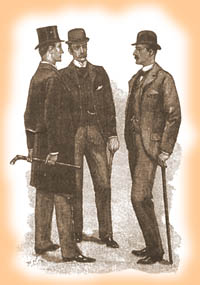 |
The adventurous gentlemen who defined the Golden Age of early British climbing (1882-1903) were, for the most part, middle and upper-middle class professionals. They relished their annual Easter and Christmas vacations and summer holidays at Wasdale Head, the centre of Lakeland climbing. These men - for brief periods - left their jobs, their families, and their cares behind, to journey to the Wastwater Hotel, where, full of a fresh and invigorating sense of adventure and exploration, they proceeded to define a wonderful new sport. |
| George
Abraham leading younger brother, Sidney, 13 at the time, up a
cliff on Blencathra. The use of a climbing rope had been introduced to
the area only a few years prior, but rope technique was non-existent.
In later years the Abraham brothers called this picture "How not to Climb".
George and Ashley Abraham captured images of the sport they were helping to formulate from this first photo, taken in 1890, through the 1920s. All climbers are in their debt for these historical treasures. |
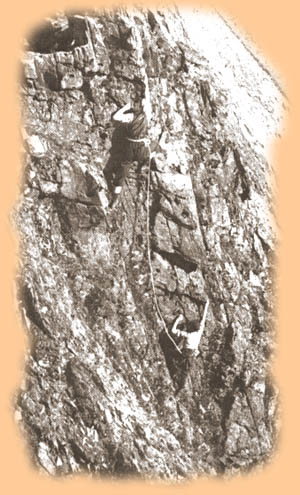 |
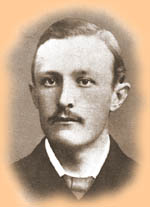 |
Walter Parry Haskett Smith
is considered the father of (British) rock climbing. A classics scholar
at Oxford who was better known for his athletic prowess than his
academics, Haskett Smith first visited Wasdale Head with a reading
party from the University in the summer of 1881. He began scrambling and then climbing up the broken cliffs of Wasdale Head in the summer of 1882, accompanied by his younger brother. They did not think of their activities as an aspect of alpine mountaineering, and used no rope. |
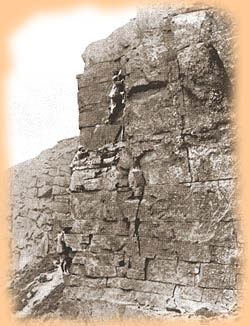 Original rope-less style of rock climbing - on Kinder Scout (pre 1900) Photo G. A. Fowkes |
| In
the summer of 1886, on the last day of his holiday,
Haskett Smith set off for a close look at the cliffs on the face of the
Great Gable. Warmed by his exertions, he succumbed to the temptation to
try for the summit of the Napes
Needle. He and others had reconnoitered the
spire on several previous occasions, but had failed to climb it. On
this day Haskett Smith succeeded, and he reached the tiny summit by
himself, using no ropes or equipment. "Its situation and shape made it unique, unmistakable; it seemed impressive and impregnable. Just as the Matterhorn had made itself the dominant challenge in the Alps simply by the thrilling beauty of its outline, so Napes Needle - on the infinitely smaller scale of Cumberland - came to represent the climbing challenge of the Lake District. Photographs of the Needle, in magazines, newspapers, and books, carried the message of what was afoot on the crags more vivedly than any words can do, and did more to attract adventurous men to Wasdale Head than any other single factor." - Alan Hankinson in The First Tigers, 1971. |
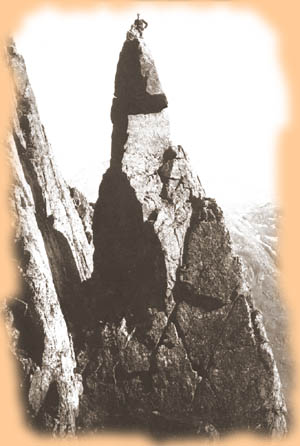 Photo Abraham Brothers |
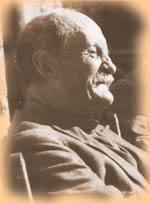 Photo C. Douglas Milner |
Haskett Smith in 1936, on the 50th anniversary of his landmark climb of the Needle. He reached the top once again, but this time with ropes and fellow climbers. |
| J. W. Robinson cheerfully "belays" two novices up Scafell Pinnacle in the early 1890s. Robinson and two of his comrades introduced the climbing rope into rock climbing activities in the Lake District in 1885. | 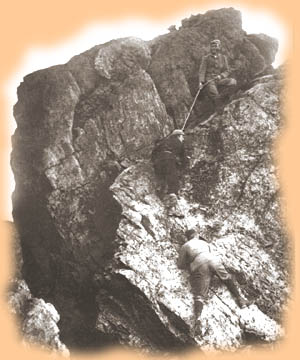 Photo Abraham Brothers |
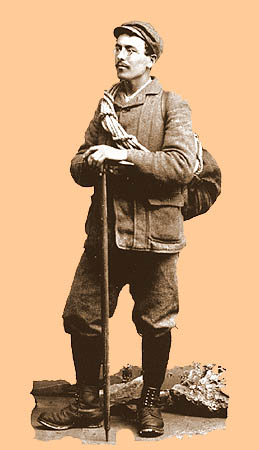 Photos Abraham Brothers |
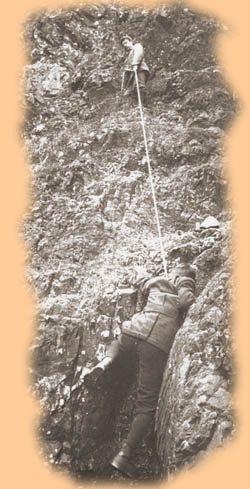 |
| Owen
Glynne Jones belays a novice
up a cliff in the Lake District. Again - little regard for rope
work, although Jones was very strong and his young friend was probably
safe enough. ca. 1895. O. G. Jones - who humorously called himself the "Only Genuine Jones", was the physics master at the London School. He is often accorded the title of the first rock gymnast, since he delighted in an acrobatic climbing style and was regarded as very agile. There are (or were) many tales of his extraordinary strength - a few of which may actually have been true. His flame burned brightly for a short period of time - then he was gone, killed in the Alps in 1903. Jones was probably the equal of any of the Elbsandstein climbers during the 1890s. |
| Kern Knotts Crack
- O. G. Jones
first did it using a top rope after several abortive
attempts, then became so efficient at it he was said
to be able to run up the crack and descend in the gully to the right,
all in seven minutes. This may have been one of the many tall tales
told of him. By current standards, the crack's about 5.7 -
but it was done in 1897. However, Jones' style evoked
criticism. According to Alan
Hankison (The
First Tigers, 1971), "Before
this no climb had ever been subjected to such careful and intensive
investigation, and there were probably many, especially among the
veterans, who shared Crowley's view that the tactics were unfair and
damaging to the tradition of pure climbing exploration."
Also, it seems that, initially, entrance to the crack
required "combined tactics" and judicious use of an ice axe. |
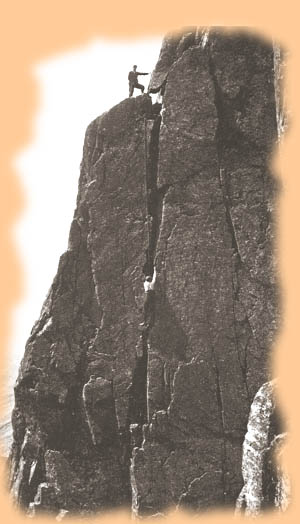 Photo Abraham Brothers |
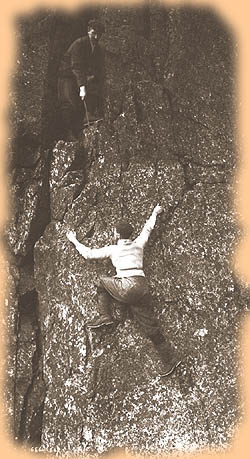 Photo Abraham Brothers |
Getting
into the crack the proper way, George Abraham belays his companion, who
uses his nailed boots efficiently as he edges on small holds. ca. 1900 How does the technical difficulty of this climb compare with what was being done in the Elbsandsteingebirge at the time? I'm guessing both areas were at approximately the same climbing grade, although it is difficult to reconcile the substantial difference in the type of rock: shattered volcanic in the Lake District and softer sandstone near Dresden. But this is only speculation. |